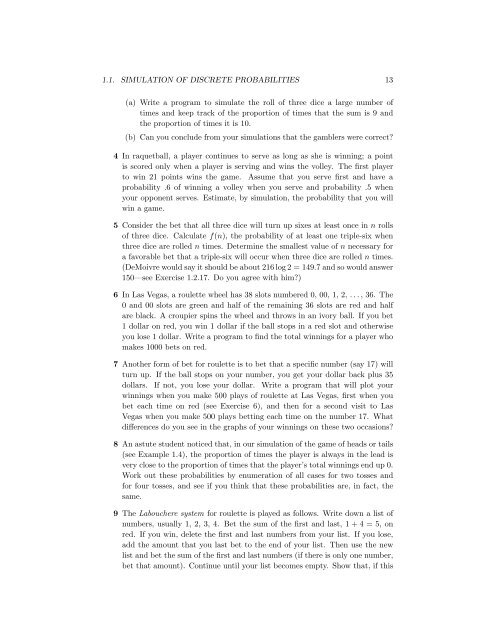Chapter 1 Discrete Probability Distributions - DIM
Chapter 1 Discrete Probability Distributions - DIM
Chapter 1 Discrete Probability Distributions - DIM
- No tags were found...
Create successful ePaper yourself
Turn your PDF publications into a flip-book with our unique Google optimized e-Paper software.
1.1. SIMULATION OF DISCRETE PROBABILITIES 13(a) Write a program to simulate the roll of three dice a large number oftimes and keep track of the proportion of times that the sum is 9 andthe proportion of times it is 10.(b) Can you conclude from your simulations that the gamblers were correct?4 In raquetball, a player continues to serve as long as she is winning; a pointis scored only when a player is serving and wins the volley. The first playerto win 21 points wins the game. Assume that you serve first and have aprobability .6 of winning a volley when you serve and probability .5 whenyour opponent serves. Estimate, by simulation, the probability that you willwin a game.5 Consider the bet that all three dice will turn up sixes at least once in n rollsof three dice. Calculate f(n), the probability of at least one triple-six whenthree dice are rolled n times. Determine the smallest value of n necessary fora favorable bet that a triple-six will occur when three dice are rolled n times.(DeMoivre would say it should be about 216 log 2 = 149.7 and so would answer150—see Exercise 1.2.17. Do you agree with him?)6 In Las Vegas, a roulette wheel has 38 slots numbered 0, 00, 1, 2, ..., 36. The0 and 00 slots are green and half of the remaining 36 slots are red and halfare black. A croupier spins the wheel and throws in an ivory ball. If you bet1 dollar on red, you win 1 dollar if the ball stops in a red slot and otherwiseyou lose 1 dollar. Write a program to find the total winnings for a player whomakes 1000 bets on red.7 Another form of bet for roulette is to bet that a specific number (say 17) willturn up. If the ball stops on your number, you get your dollar back plus 35dollars. If not, you lose your dollar. Write a program that will plot yourwinnings when you make 500 plays of roulette at Las Vegas, first when youbet each time on red (see Exercise 6), and then for a second visit to LasVegas when you make 500 plays betting each time on the number 17. Whatdifferences do you see in the graphs of your winnings on these two occasions?8 An astute student noticed that, in our simulation of the game of heads or tails(see Example 1.4), the proportion of times the player is always in the lead isvery close to the proportion of times that the player’s total winnings end up 0.Work out these probabilities by enumeration of all cases for two tosses andfor four tosses, and see if you think that these probabilities are, in fact, thesame.9 The Labouchere system for roulette is played as follows. Write down a list ofnumbers, usually 1, 2, 3, 4. Bet the sum of the first and last, 1 + 4 = 5, onred. If you win, delete the first and last numbers from your list. If you lose,add the amount that you last bet to the end of your list. Then use the newlist and bet the sum of the first and last numbers (if there is only one number,bet that amount). Continue until your list becomes empty. Show that, if this
















